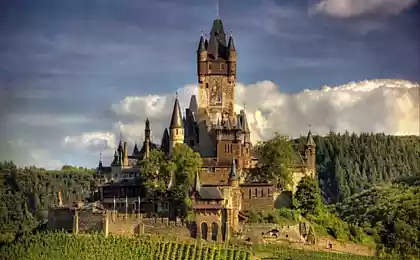477
The castle of Monteagudo - guard of Spain
The castle of Monteagudo is situated on top of the limestone rock on the slopes of which lies the village of Monteagudo, 5 kilometers from Murcia and 10 km from Orihuela. At the foot of the fortress is the "old road Monteagudo", which connects the two important routes, Murcia and Castile. The name of the castle Castillo de Monteagudo came from the name of the mountain on which it is located. In Arabic sources it is found under the name Muntaqud and in Spanish texts as Montagut or MONTAGUD in the later middle ages.

All of these names comes from the Latin "Monte acutum" or "Sharp mountain". Thanks to its strategic location on the mountain was inhabited by people since the Bronze age (2000 years BC). Romans have not paid attention to this place and the opinion of various historians at the foot of the mountain once housed a small town that was destroyed during the wars between the Byzantines and the Visigoths. The walls are covered with lime mortar and provided with rectangular towers, which are located very close to each other.

The Foundation of the fortress is adapted to the surface: the fortress stands on two ledges at different levels. In the lower part of the fortress can be accessed from the southern side, going down the path, and then climbing the stairs. Along this North-Western side of the fortress are large springs, barns, shops and other facilities.The fortress is very well preserved and represents one of the most impressive monuments of Murcia. In recent years, there are archaeological excavations and restoration work. During recent archaeological excavations have been found funerary urns of the Bronze age, and fragments of pottery and architectural monuments of the Iberian and Roman culture.

Also not to mention the monument dedicated to the veneration of the sacred heart of Jesus (Corazon de Jesus) (14 metres high) located on the top of the cliff. This sculpture, depicting Christ, was built here in 1951, Nicolas Martinez (Nicolas Martinez). However, it is a replica of the original sculpture, built in 1926 with the support of the mayor of Murcia, Francisco martínez garcía (Francisco Martinez Garcia) and destroyed during the Second Republic.
Source: /users/117

All of these names comes from the Latin "Monte acutum" or "Sharp mountain". Thanks to its strategic location on the mountain was inhabited by people since the Bronze age (2000 years BC). Romans have not paid attention to this place and the opinion of various historians at the foot of the mountain once housed a small town that was destroyed during the wars between the Byzantines and the Visigoths. The walls are covered with lime mortar and provided with rectangular towers, which are located very close to each other.

The Foundation of the fortress is adapted to the surface: the fortress stands on two ledges at different levels. In the lower part of the fortress can be accessed from the southern side, going down the path, and then climbing the stairs. Along this North-Western side of the fortress are large springs, barns, shops and other facilities.The fortress is very well preserved and represents one of the most impressive monuments of Murcia. In recent years, there are archaeological excavations and restoration work. During recent archaeological excavations have been found funerary urns of the Bronze age, and fragments of pottery and architectural monuments of the Iberian and Roman culture.

Also not to mention the monument dedicated to the veneration of the sacred heart of Jesus (Corazon de Jesus) (14 metres high) located on the top of the cliff. This sculpture, depicting Christ, was built here in 1951, Nicolas Martinez (Nicolas Martinez). However, it is a replica of the original sculpture, built in 1926 with the support of the mayor of Murcia, Francisco martínez garcía (Francisco Martinez Garcia) and destroyed during the Second Republic.
Source: /users/117























